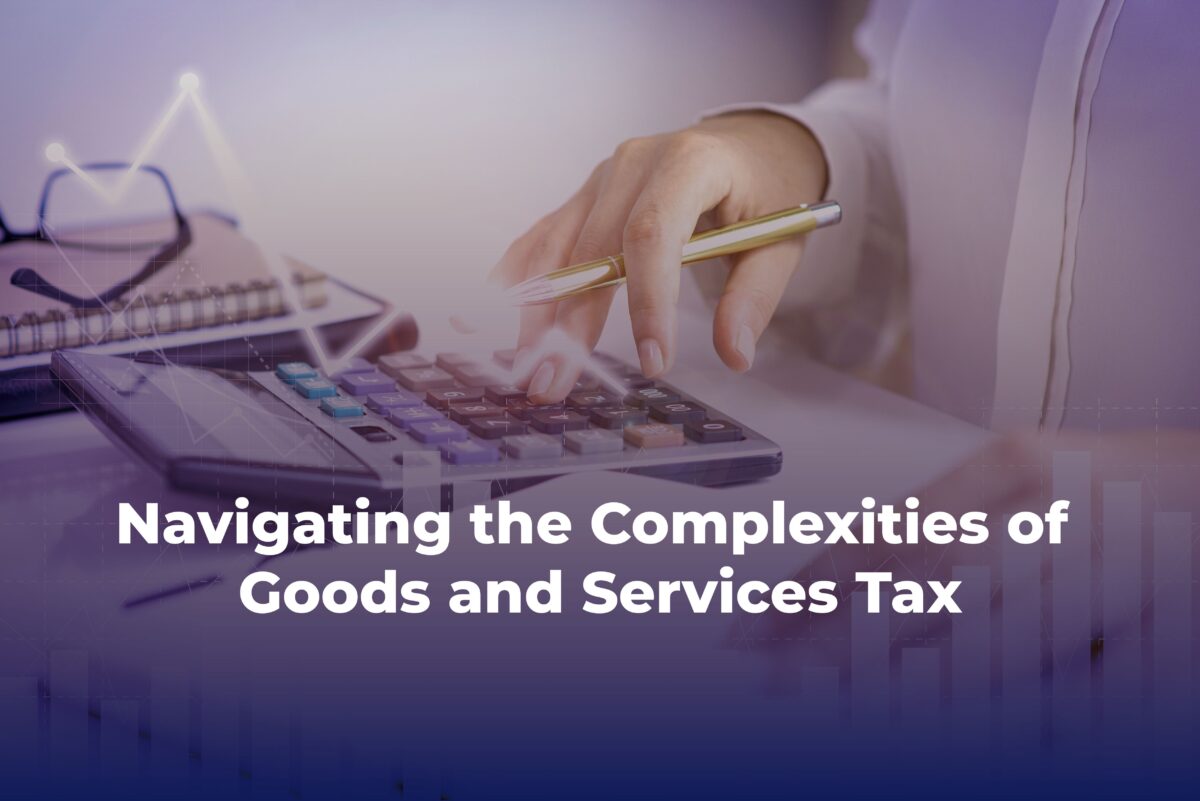Navigating the Complexities of Goods and Services Tax

Most countries that implement a common taxation system that have a single unified tax rate throughout the country. Goods and Service Tax is a comprehensive, destination-based tax on the supply of certain goods and services. It was meant to replace the previous tax iterations, such as VAT, excise, import and export duty, etc., and make the taxing process easier and less convoluted.
The business adds the tax to the product’s price, and the customer pays the sales price of the goods and services consumed. The business collects the tax portion of the product price and forwards it to the respective government authorities.
One of the benefits of GST is that it makes it easier to track the tax calculation and prevent tax evasion. The Central Board of Indirect Taxes and Customs (CBIC) is the regulatory body governing all changes and amendments regarding this tax.
What is GST?
GST is a destination-based, multi-stage, comprehensive tax levied at each stage of value addition. It replaced various indirect taxes in the country implemented during the pre-GST era and successfully assisted the Indian Government in achieving its ‘One Nation One Tax’ agenda.
GST is levied from the manufacturing stage to the final consumption of the product. The credit of GST paid shall be available for setoff. The GST is a value-added tax (VAT) primarily levied on most goods and services sold for domestic consumption. Consumers pay the GST, but businesses selling the goods and services remit it to the government.
GST is applied to the final market price of goods and services produced internally, which reflects the maximum retail price. Customers must pay this tax as part of their final price when purchasing goods or services. The seller collects it and is obligated to remit it to the government, indicating the indirect incidence.
Also Read: Income Tax Act 1961
Components of GST
India’s Goods and Services Tax (GST) system comprises several components.
- Integrated Goods and Services Tax (IGST)
- State Goods and Services Tax (SGST),
- Central Goods and Services Tax (CGST)
- Union Territory Goods and Services Tax (UTGST).
Each component plays a crucial role in the country’s taxation framework.
Integrated Goods and Services Tax (IGST)
The Integrated Goods and Services Tax (IGST) is a tax imposed on the interstate supply of goods and/or services, imports, and exports. It operates under the governance of the IGST Act. The central government collects taxes under IGST, which are distributed among the respective states.
For example, if a trader from West Bengal sells goods worth Rs. 5,000 to a customer in Karnataka, IGST applies due to the interstate nature of the transaction. Assuming a GST rate of 18%, the trader will levy Rs. 5,900 for the goods. The collected IGST amounts to Rs. 900, which the Central Government receives.
State Goods and Services Tax (SGST)
The State Goods and Services Tax (SGST) is a tax on intrastate transactions within the same state. Both State GST and Central GST are imposed on the intrastate supply of goods and/or services.
Under the SGST Act, the state imposes and collects SGST on goods and/or services bought or sold within its jurisdiction. The respective state government solely claims the revenue generated through SGST.
For example, if a trader from West Bengal sells goods worth Rs. 5,000 to a customer within the state, both CGST and SGST are applicable. Assuming a GST rate of 18%, it is split equally into 9% for each CGST and SGST. In this scenario, the trader will charge a total of Rs. 5,900, of which Rs. 450 will be remitted to the West Bengal state government as SGST.
Central Goods and Services Tax (CGST)
Similar to SGST, the Central Goods and Services Tax (CGST) applies to intrastate transactions, those occurring within the same state. The CGST Act governs CGST, and the Central Government collects its revenue.
Continuing from the previous scenario, if a trader from West Bengal sells goods worth Rs. 5,000 to a customer within the state, CGST and SGST are applicable. Assuming a GST rate of 18%, it is divided equally into 9% for each CGST and SGST. Consequently, the trader will charge a total of Rs. 5,900. Out of the revenue earned from CGST, specifically Rs. 450, the Central Government receives it as CGST.
Union Territory Goods and Services Tax (UTGST)
The Union Territory Goods and Services Tax (UTGST) mirrors the State Goods and Services Tax (SGST) and is imposed on the supply of goods and/or services within the Union Territories (UTs) of India.
Applicable to the supply of goods and/or services in regions such as the Andaman and Nicobar Islands, Chandigarh, Daman Diu, Dadra, Nagar Haveli, and Lakshadweep, UTGST is regulated by the UTGST Act. The respective Union Territory government collects revenue from UTGST.
Replacing SGST in Union Territories, UTGST is charged in addition to CGST within these regions.
What is GSTIN
The Goods & Services Tax Identification Number (GSTIN) is a 15-digit unique identification number associated with your firm or name once you register under the GST regime in India. It comprises state, PAN, and entity-based information. The GSTIN is crucial for various GST-related procedures, including filing returns, claiming input tax credits, and paying taxes.
Before GST implementation, state tax authorities assigned dealers registered under the state VAT law a unique TIN number. Similarly, the Central Board of Indirect Taxes and Customs (CBIC) assigned service tax registration numbers to service providers.
Under the GST regime, all registered taxpayers are consolidated into a single platform for compliance and administration. They receive registration under a single authority, streamlining processes and ensuring uniformity.
GST Calculation
Since the introduction of GST, simplifying the indirect taxation regime has simplified calculating applicable taxes. Now, the GST rates for different goods or services can be calculated based on the nature of the transaction—whether it’s inter-state or intra-state.
Intra-state GST tax calculator
In the case of Intra-State transactions, GST can be calculated as follows:
CGST = Applicable GST Rate / 2 (for 28%, CGST will be 28/2=14%)
SGST / UTGST = Applicable GST Rate / 2 (for 28%, SGST will be 28/2=14%)
In other words, CGST + SGST / UTGST = Applicable GST Rate
Inter-State GST tax calculator
In the case of Inter-State transactions, GST can be calculated as follows:
IGST = Applicable GST rate
Note: Where applicable, the GST Compensation Cess should be added to the applicable GST rate for the correct tax calculations. Even a GST credit calculator will be based on the same principles.
Thus, a simple formula arises:
GST Amount = (Original Cost*GST Rate Percentage) / 100
Net Price = Original Cost + GST Amount
Conclusion
As India continues its journey with GST, it is imperative for policymakers, businesses, and citizens to collaborate in addressing these challenges and maximizing the benefits of this landmark tax reform. With continuous refinement, effective implementation, and robust governance mechanisms, GST has the potential to catalyze India’s journey towards becoming a globally competitive economy, driving prosperity and inclusive growth for all.
Read More: Key Considerations in Evaluating SEO Packages for E-Commerce Websites











